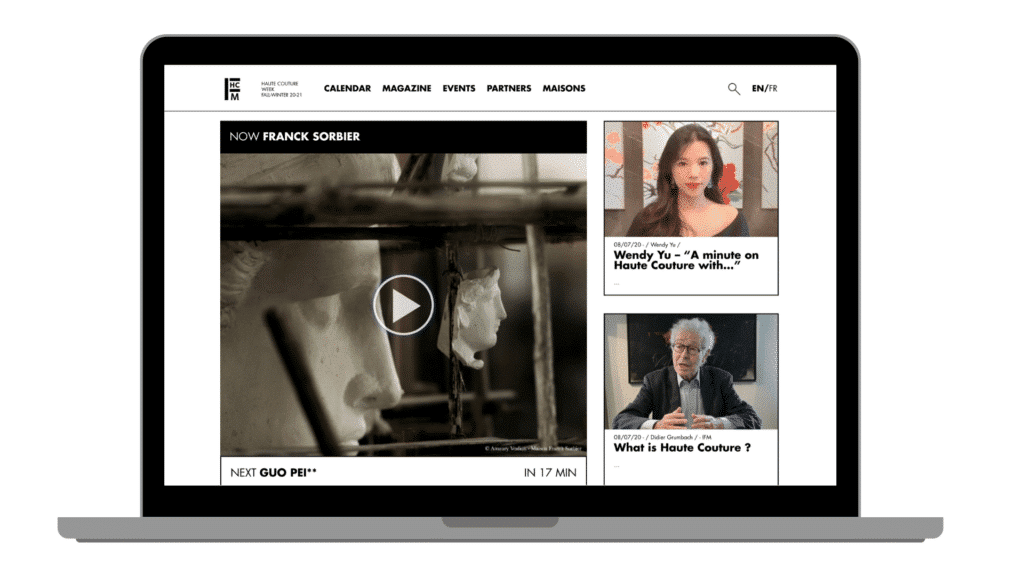As the timeline for fashion weeks drew closer, and the repercussions of Covid saw no signs of slowing down, brands and fashion councils had to rethink the way they would present collections in 2020. Digital acceleration has sped up at an unprecedented rate thanks to the global pandemic, and even as restrictions ease, the future of fashion looks solidly ‘phy-digital.’ Our CEO, Michael Jais joined French Founders’ recent summit to speak with Pascal Morand, Executive President of Fédération de la Haute Couture et de la Mode about the process of creating Paris’ first digital fashion week. From their conversation, it was apparent that whilst digital will not replace the physical, it allows for numerous benefits both creatively and logistically.
Digitalize Fashion Week from FrenchFounders on Vimeo.
The art of Digital Fashion Weeks: Key Takeaways from French Founders’ Online Summit
New presentation formats breed stronger consumer connections and creativity
Michael noted that digital fashion weeks are allowing consumers to have a much more “intimate experience and emotional connection” with the brands they love. Not only has fashion week become more accessible, but the way brands have chosen to showcase their collections, whether it be through video lookbooks, digital storytelling or behind-the-scenes sneak peeks, has allowed them to build stronger connections with their target audience.
Building brand value is essential for companies in the fashion industry if they want to survive the ramifications of Covid. Consumers look to understand a brand’s messaging, values, and what they stand for, and digital fashion weeks are a way to express this through what they choose to display. For example, designer Yuima Nakazato showed a more intimate look at the process behind the design and commission of his pieces. This allowed him to display the dedication, detail, and craft that goes into each garment, which can’t necessarily be seen on the runway. As Pascal stated: “The whole point is to have a dialogue through the imagination of the designers and brands on one side, and the clients on the other side.”
Going digital removes boundaries and allows brands to cater to all of their stakeholders
Pascal noted that whilst fashion weeks had opened up to the wider public, it was still essential to cater for important stakeholders such as industry professionals, buyers, and press contacts: “We have one part dedicated to the brands, which is the videos and the calendars, but on the other hand we also have the magazine, with a plethora of content for different markets including behind-the-scenes videos, concerts regional information, roundtables and more.”
There are no limits when it comes to digital, and so there is more room for brands to be able to cast a wider net, without having to exhaust more resources. This also allows for an unlimited number of key markets to be reached at the same time, without having to be selective in terms of who to invite to shows, or who to send new season samples to. “The Adventures of Zoooom with his friends by Virgil Abloh” garnered 2.8 million views in less than four days on YouTube, plus 1.2 million on InstagramTV” making it one of the most popular videos by Louis Vuitton in its entire history, also demonstrating the potential reach of these activities.
The virality of Louis Vuitton’s show just supports the ongoing shift towards social media and using digital platforms to build hype and reach a global audience. This is also extended further, via digital showrooms and the ability to launch collections to a host of industry professionals, in different markets, at the exact same time – whilst tracking exactly which products have the most downloads, interest and attention.
The future is phy-digital
Although this year there is a new digital fashion week on the block, it is likely that as restrictions ease, brands will still place precedence on physical experiences and events. However, it is for certain that digital is here to stay, and the future will be a mix of the two. “We have plans to maintain digital fashion weeks in the future, this is what is happening with the platform and people are demanding content” Pascal stated. This change is supported by the 64% increase in online content as a result of Covid, as well as the widespread acceleration of digital solutions across industries globally.
There is no doubt that this process will continue to be embraced by brands in fashion, beauty, and luxury – consumers now are looking for ways to connect with brands, whether that be by understanding their values, or through the creative content they put out on their social channels. It’s likely that digital will provide brands with the tools they need to connect to a modern consumer in a more genuine way, supporting physical assets along the journey.

